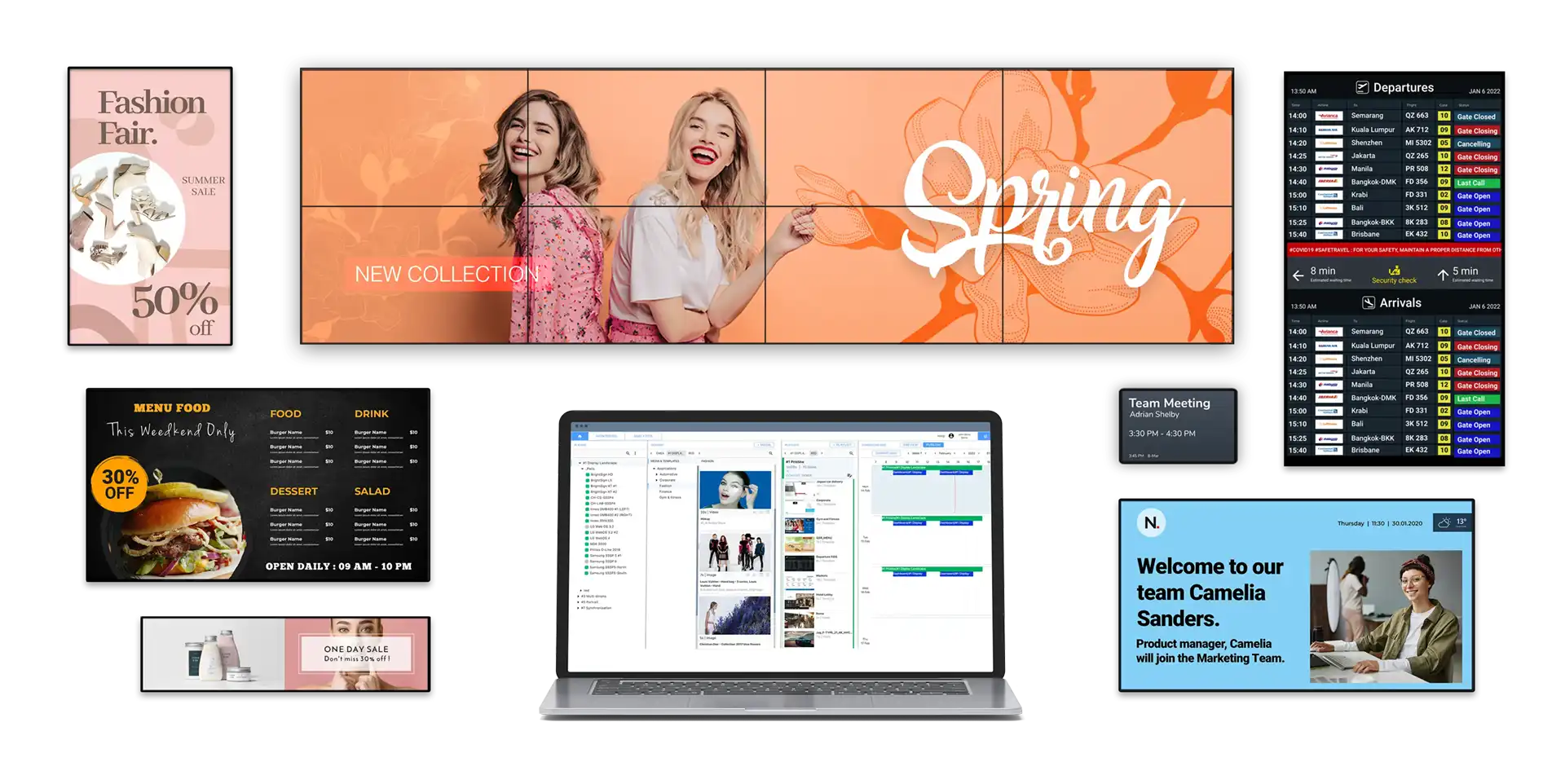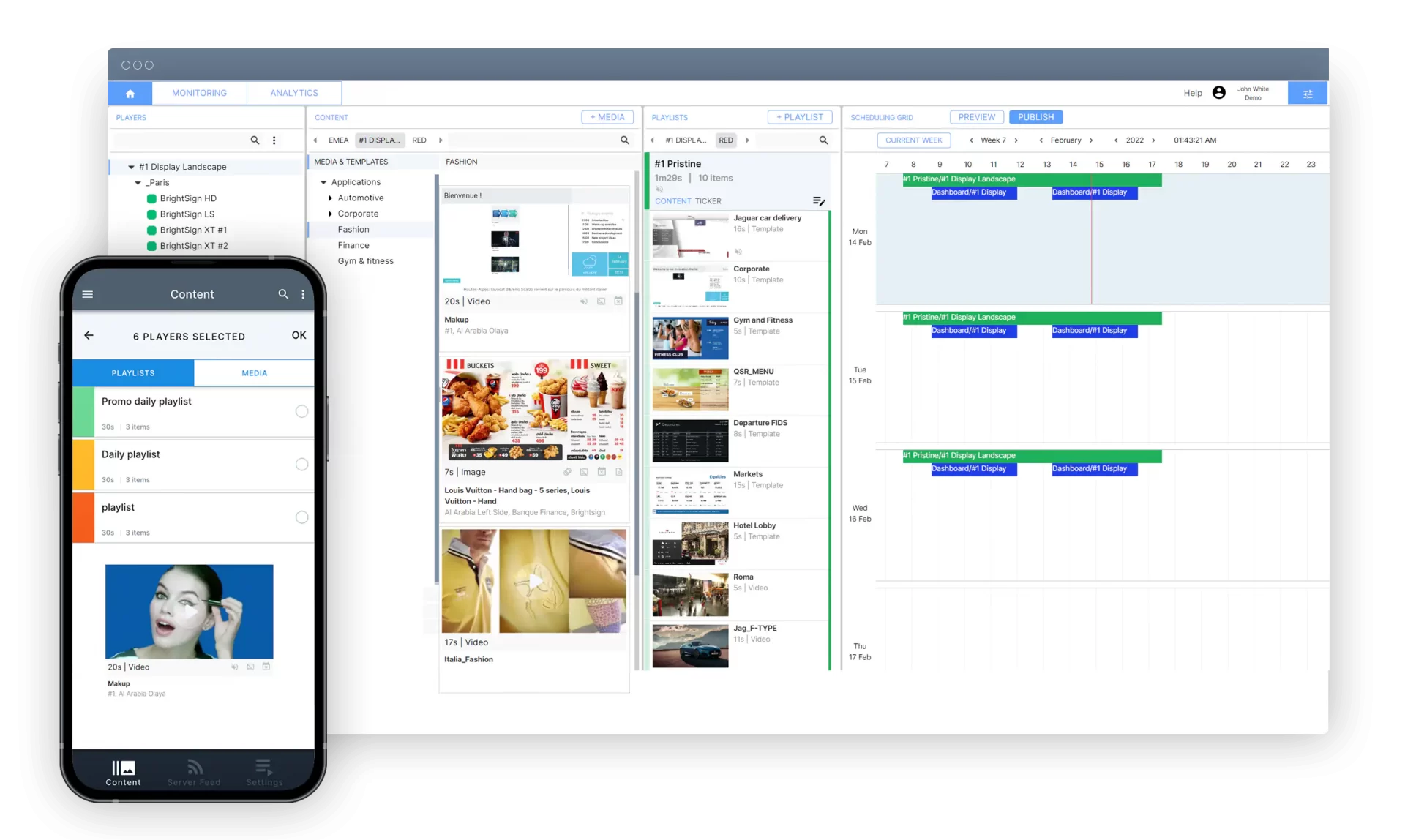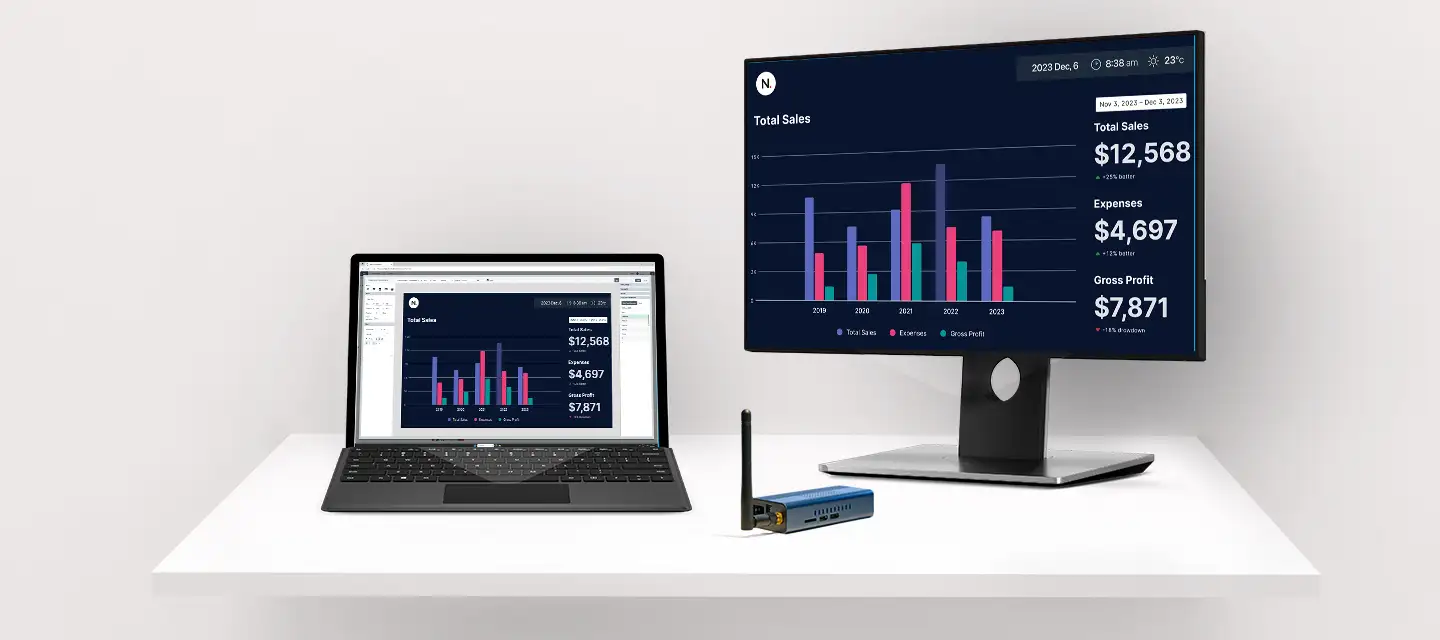An Introduction to the Digital
Signage Software Market
So much software to choose from
“People looking for digital signage software have almost too many products to choose from with more software being added every day. Having all these options is pretty neat, but it’s also a bit of a problem.
For example, product “A” may have the right price but it’s missing some critical features. Product “B” is too unstable and requires constant attention. Product “C” is just too difficult to deploy and is a pain to use.
Having too many choices is almost worse than not having enough. You can’t keep up with all the digital signage software already on the market and you can’t tell which ones are worth your attention.
So what makes digital signage software the right choice for you? That’s what we’ll try to answer below.
Let’s talk about the basics…
Here are the basic building blocks behind any digital signage content management system.
- The Server
- The Player content playback software (or playback device)
- The Content Manager user interface

The digital signage server software
Every content manager has a server component. It’s basically the “brains” of the system that handles many important tasks like managing players, content, schedules, and playback rules. Some content managers also include content design tools and software apps that let you create new media from scratch. These tend to be near the top of the scale in terms of usefulness because you don’t have to load another software application to perform basic content updates.
The best products are built on top of a robust database capable of handling complex data structures and multiple transactions efficiently. An inefficient database will impact productivity and cause instability so it’s important to consider your current and future needs. Look for digital signage software that scales easily and continues to be responsive as you add more players and users. The last thing you want is for the software to slow to a crawl because there are too many users accessing the system.
Planning a big player rollout?
Thinking of deploying a large number of players across multiple countries? Consider products that support content delivery networks (CDNs). This is the most efficient content delivery method for large groups of players spread out over vast distances. Look for solutions that are compatible with world-class hosting services such as Microsoft Azure, Rackspace, and other well-known service providers.
But what about reliability? Well, most digital signage software products support single servers which are fine for small deployments and non-critical applications. However, a single server solution just won’t do if you’re an advertising network operator or in any other industry that requires 24/7/365 reliability. These types of businesses need a CMS product that supports multiple servers with load balancing so they can respond to local demand and ensure there are never any service interruptions.
Nobody wants to see blank screens so having a reliable solution is certainly worth investigating.
When evaluating digital signage products, it’s important to compare each server’s capabilities, technical requirements, and overall operating costs.
Which is best for you… on-premise & self-hosted or cloud-based?
CMS Servers come in two flavors. On-premise and cloud-based (aka. Software as a Service or SaaS). The version you choose will depend on your business model, funding, growth plans, etc.
Folks who put a premium on security and who require total control should look at an on-premise (self-hosted) solution. It’s an option that requires a larger capital investment up-front but you will be in complete control of your environment. For example, you can choose where to host your software and how much to invest in hardware.
An on-premise solution will make sense if you’re in the financial sector where security is your biggest concern or if you want to act as a cloud hosting provider to your own customers. In this case, you either host the server on your own premises or you can rely on a hosted/virtual server environment for more flexibility.
Cloud or SaaS-based solutions are also extremely popular because they require no up-front capital expense. You’re basically renting the software and you don’t have to worry about running your own back-end server with all the costs and complexity that come with it.
The choice is clear if you’re starting out with a few screens. In this case, a cloud-hosted solution makes the most sense because your costs will scale as you add more screens and locations. You don’t have the added expense of hiring technical staff to babysit your equipment so you can concentrate on the more important aspects of your business. It’s also important to note many cloud solutions providers will work with you as your needs grow to help keep deployment costs in check.
Is the solution customizable?
No software is perfect. In fact, most commercially available digital signage software products are designed for a large audience. It just makes good business sense. Software developers try and appeal to the widest possible market and offer products that will be broadly accepted.
However, problems arise when you’re satisfied with the overall CMS solution but you’re just missing that one feature that would increase your productivity or provide a competitive edge.
So what happens when you need a feature that isn’t available or the ones currently offered won’t fulfill your needs? That’s when software development kits (aka. SDKs) come into play. SDKs let you bypass a product’s user interface or automate built-in processes so you can achieve your goals. They let you customize the standard product “out of the box” and make it yours.
If this sounds like you then you should definitely consider digital signage products that offer software development kits or other means to manipulate the CMS server and make it perform the way you need.
Since customization requires access to the back-end server, SDKs are available to on-premise server users.
The questions I usually ask when researching any CMS server products are:
- Is the CMS database restricted in any way?
- Does the CMS Server support load balance?
- Is the product easily scalable?
- What is the database technology behind the product?
- Are there any limitations as to the number of users and players that the system can support?
The digital signage player is in charge of playing back the content across displays
Digital signage player software comes in all sorts of “flavors”. There are apps built using HTML or Flash technologies while professional software applications are built using standard programming languages. The former is used mostly on “System on a Chip” (SOC) hardware embedded in LED flat screens and open-source software while you will find proprietary software designed, marketed, and sold for specific operating systems and player hardware.
LED screen manufacturers are actively marketing SOC-based digital signage displays to grow their market share. There can be some significant savings gained by embedding the player hardware inside the screen which helps lower costs and simplify deployments. Disadvantages range from a lack of compatibility with third-party CMS software to a lack of support for some popular content formats. However, SOC player hardware is improving all the time with more features and enhanced playback capabilities. One big drawback of using embedded SOC/LED screens is that you’re often stuck using the manufacturer’s own CMS software which tends to offer basic features and limit upgrade options. In some cases, newer generation software isn’t always compatible with older screens which creates all sorts of problems.
Things are improving as screen manufacturers recognize the advantages of opening up their hardware to more software products. Take for example the latest generation of SSO digital displays that are powered by Google Android: Panasonic Af1, Philips D-line signage displays, and many other brands.

Open source vs. proprietary software
There is a battle raging in digital signage land. This battle centers around the so-called open source (aka. “free”) and proprietary content management software. On one hand, you get software with limited support and no real company behind the product. On the other side, you have commercial products that are available through paid software licenses or fixed monthly fees.
When free isn’t “free”
Free software is often based on Flash or web technologies and we can trace a lot of these products back to university projects and commercial products that were released to the open-source community. Proprietary solutions tend to be designed for specific operating systems or even specific hardware platforms.
It’s important to note that free and open-source software has hidden costs. For example, these products may require additional development, customization, and testing before they can be used in a commercial project. Support is often available through online forums with no dedicated support team to respond to user requests.
It’s no surprise that open-source digital signage products have become quite popular in the educational sector since students can act as their own support and development staff. However, most companies can’t afford to allocate internal resources to support these activities.
Why commercial products still rule
The software industry invests millions of dollars into research and development (R&D) each year to maintain market share and gain a competitive advantage in the highly competitive digital signage market. Agile companies that can capitalize on new trends and emerging technologies replace those that fail to innovate and fall behind. R&D budgets drive the introduction of innovative products, making this progress possible within the commercial software sector.
Commercial software, renowned for its extensive features and user-friendliness, often outperforms open-source alternatives due to dedicated resources solely focused on coding, testing, and optimizing the software, resulting in enhanced stability.
Commercial software developers also benefit from close collaborations with hardware manufacturers, ensuring certifications for specific PCs, media players, and screen devices.
When selecting commercial digital signage player software, prioritize products developed specifically for your intended operating system. Evaluate the developer’s track record and R&D investments as vital indicators of product quality.”
What to look for in a digital signage media player:
- Products that are available for multiple operating systems and hardware types.
- Native software (designed for a specific operating system, not Flash or HTML based).
- Products that support multiple screens and resolutions (including 4K).
- Products that support popular media formats without any conversion.
- Software that is designed for 24/7/365 use.
- Products that are easy to install and require no maintenance.

The content manager user interface
The user-facing component of every CMS product is the interface or UI.
Well-designed digital signage software products will tend to have a UI that is efficient and easy to use. A complex and obscure UI can kill a product, no matter how efficient the CMS server or how reliable the standalone player software is. None of this will matter if your staff won’t touch the product.
If you’re researching various Digital sign software, do yourself a favor and spend some time testing the User Interface. Look for features that will save time when performing repetitive tasks or let you create content inside the app. Pay attention to products that are easy to install and maintain. Ask your vendor if the product you’re considering supports multiple devices and if you need to install additional software or apps to manage your content. Consider products that are delivered through a web-based interface so there is no local software to install. These products tend to be more flexible since you can connect to the Content manager from any device whether it’s a PC, tablet, or smartphone.
The popularity of live news sources and social media means you will need a product that supports external data sources like RSS feeds and other database formats. Make sure your chosen solution supports a wide range of data sources including social media. These features are becoming essential to any project.
What makes a good User Interface?
- Ease of use.
- No local software to install and maintain.
- Adapts to various devices.
- Lets users easily monitor the network status.
- Offers content previews.
- Includes built-in content creation tools.
- Database and social media support.
- Multilingual.
